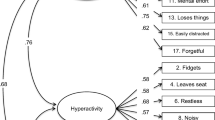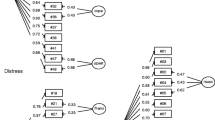Abstract
My commentary is organized into four sections. First, I summarize the reasons for the original interest in fitting symmetric bifactor models to ADHD data. Second, I summarize the concerns that Burns and colleagues raised with respect to fitting symmetric bifactor models to ADHD item-level data and describe their recommended alternative approach. Third, I raise two concerns that I had with their manuscript. Fourth, I conclude with a caveat and a general question about the merits of the continued study of the factor structure of ADHD symptoms.
Similar content being viewed by others
Notes
For brevity, I ignore models that consider three specific factors for inattention, hyperactivity, and impulsivity. Most studies combine hyperactivity-impulsivity into a single factor. This distinction is not relevant to the ideas that are developed here.
References
Arias, V. B., Ponce, F. P., & Nunez, D. E. (2018). Bifactor models of attention-deficit/hyperactivity disorder (ADHD): An evaluation of three necessary but underused psychometric indexes. Assessment, 25(7), 885–897. https://doi.org/10.1177/1073191116679260.
Capdevila-Brophy, C., Artigas-Pallares, J., Navarro-Pastor, J. B., Garcia-Nonell, K., Rigau-Ratera, E., & Obiols, J. E. (2014). ADHD predominantly inattentive subtype with high sluggish cognitive tempo: A new clinical entity? Journal of Attention Disorders, 18(7), 607–616. https://doi.org/10.1177/1087054712445483.
De Los Reyes, A., Augenstein, T. M., Wang, M., Thomas, S. A., Drabick, D. A. G., Burgers, D. E., et al. (2015). The validity of the multi-informant approach to assessing child and adolescent mental health. Psychological Bulletin, 141(4), 858–900. https://doi.org/10.1037/a0038498.
Eid, M., Geiser, C., Koch, T., & Heene, M. (2017). Anomalous results in G-factor models: Explanations and alternatives. Psychological Methods, 22(3), 541–562. https://doi.org/10.1037/met0000083.
Heinrich, M., Zagorscak, P., Eid, M., & Knaevelsrud, C. (2018). Giving G a meaning: An application of the bifactor-(S-1) approach to realize a more symptom-oriented modeling of the Beck depression inventory-II. Assessment, 1073191118803738, doi:https://doi.org/10.1177/1073191118803738.
Lahey, B. B., Pelham, W. E., Schaughency, E. A., Atkins, M. S., Murphy, H. A., Hynd, G., Russo, M., Hartdagen, S., & Lorys-Vernon, A. (1988). Dimensions and types of attention deficit disorder. Journal of the American Academy of Child & Adolescent Psychiatry, 27(3), 330–335.
Lahey, B. B., Zald, D. H., Perkins, S. F., Villalta-Gil, V., Werts, K. B., Van Hulle, C. A., et al. (2018). Measuring the hierarchical general factor model of psychopathology in young adults. International Journal of Methods in Psychiatric Research, 27(1). https://doi.org/10.1002/mpr.1593.
Martel, M. M., von Eye, A., & Nigg, J. T. (2010). Revisiting the latent structure of ADHD: Is there a 'g' factor? Journal of Child Psychology and Psychiatry, 51(8), 905–914.
McGee, R., Williams, S. M., & Silva, P. A. (1985). Factor structure and correlates of ratings of inattention, hyperactivity, and antisocial behavior in a large sample of 9-yr-old children from the general population. Journal of Consulting & Clinical Psychology, 53(4), 480–490.
Milich, R., Balentine, A. C., & Lynam, D. R. (2001). ADHD combined types and ADHD predominately inattentive type are distinct and unrelated disorders. Clinical Psychology: Science and Practice, 8(4), 463–488.
Miyake, A., & Friedman, N. P. (2012). The nature and organization of individual differences in executive functions: Four general conclusions. Current Directions in Psychological Science, 21(1), 8–14. https://doi.org/10.1177/0963721411429458.
Murray, A. L., Ribeaud, D., Eisner, M., Murray, G., & McKenzie, K. (2019). Should we subtype ADHD according to the context in which symptoms occur? Criterion validity of recognising context-based ADHD presentations. Child Psychiatry and Human Development, 50(2), 308–320. https://doi.org/10.1007/s10578-018-0842-4.
Pelham Jr., W. E. (2001). Are ADHD/I and ADHD/C the same or different? Does it matter? Clinical Psychology: Science and Practice, 8(4), 502–506.
Taylor, E., & Sandberg, S. (1984). Hyperactive behavior in English schoolchildren: A questionnaire survey. Journal of Abnormal Child Psychology, 12(1), 143–155. https://doi.org/10.1007/bf00913466.
Toplak, M. E., Pitch, A., Flora, D. B., Iwenofu, L., Ghelani, K., Jain, U., & Tannock, R. (2009). The unity and diversity of inattention and hyperactivity/impulsivity in ADHD: Evidence for a general factor with separable dimensions. Journal of Abnormal Child Psychology, 37(8), 1137–1150. https://doi.org/10.1007/s10802-009-9336-y.
Willcutt, E. G., Nigg, J. T., Pennington, B. F., Solanto, M. V., Rohde, L. A., Tannock, R., Loo, S. K., Carlson, C. L., McBurnett, K., & Lahey, B. B. (2012). Validity of DSM-IV attention deficit/hyperactivity disorder symptom dimensions and subtypes. Journal of Abnormal Psychology, 121(4), 991–1010. https://doi.org/10.1037/a0027347.
Author information
Authors and Affiliations
Corresponding author
Ethics declarations
Conflict of Interest
The author has no conflicts of interest to declare.
Ethical Approval and Informed Consent
No human subjects research was reported. Hence, questions about ethical approval and informed consent are not applicable.
Additional information
Publisher’s Note
Springer Nature remains neutral with regard to jurisdictional claims in published maps and institutional affiliations.
Rights and permissions
About this article
Cite this article
Willoughby, M.T. Commentary on Application of the Bifactor S-1 Model to Multisource Ratings of ADHD/ODD Symptoms: An Appropriate Bifactor Model for Symptom Ratings. J Abnorm Child Psychol 48, 901–904 (2020). https://doi.org/10.1007/s10802-020-00629-4
Published:
Issue Date:
DOI: https://doi.org/10.1007/s10802-020-00629-4




